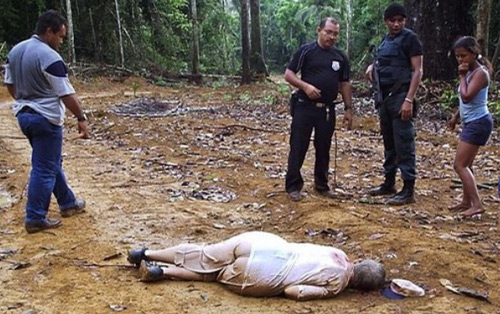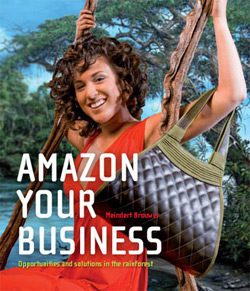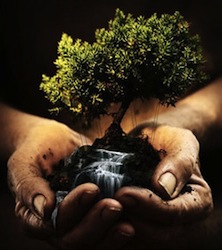Tensions spilled into the streets today with roadblocks set up by an indigenous group led by Alberto Pizango Chota. The reason for the barricades is to protest new decrees that would allow oil & mining companies to enter the territory without their consent or even consultation.
President Alan Garcia claims the laws are necessary to implement a Free Trade Agreement with the USA. Any resource & the land over it, on it, or under it, belong, in effect, to the state.
He does so against the backdrop that just last year his close friend & former campaign manager, Jorge del Castillo, was forced to resign from a government post for presiding over bribery payments. Those payments implicate the state-owned Petroperu Oil Company. Petroperu’s holdings include the world’s oldest large-scale oilfield – La Brea y Pariñas – first discovered in 1869 & whose original property title was deeded by the Liberator himself — Simon Bolívar.
Amazonian communities in the area fear that 70% of the rainforest would be leased for oil & gas exploration. That, they say, would threaten their way of life & endanger the environment. Toxic waste from mining & drilling could contaminate local food sources. Infrastructure development would re-shape the landscape. And the corrupting influence of money, they estimate, would mostly line the pockets of outsiders & wealthy investors.
Oil especially has earned a reputation as a ‘point source’ asset in such other places as Nigeria. It generates fabulous wealth for a few but little for wider economic & social development.
Discontent boiled over when the protest culminated in an ugly clash along a stretch known as the Devil Curve Jungle Highway after the government, in a pre-emptive maneuver, declared a state of emergency. It suspended civil liberties & sent in a military battalion to enforce order.
Two days of bloody conflict later & between 600 armed guards & about 5,000 demonstrators left scores dead.
Locals decried that the military fired live munitions from helicopters onto the crowd below armed only with machetes & wooden spears. Accounts vary about provocative & poorly trained troops arriving from the south of the country. In the equally uncertain aftermath up to 100 civilians perished, a couple dozen soldiers (including 9 taken hostage & killed), plus a handful of children.
The government is accused of burning bodies to hide the exact death toll.
Not since the Shining Path in the 1990s has such political violence roiled the country.
Garcia’s approval rating has plummeted & several ministers have resigned.
— reporting from Bagua Province Peru, this is Marañón Canyon Cacáo
In the dust up, Brian, unaware, accidentally got caught out there for an up-close & personal taste of South American politics.
While riding thru Jáen, a narco haven for laundering coke money into real estate deals, he notices every house & store shuttered. It’s only 11:30AM… too late for sleeping / too early for siesta. He hears a crowd somewhere. Then someone shouts “there’s a gringo on a motorcycle”.
Reflexive prejudice around these parts harbors an acute distaste for Yanks because they’re emblematic of all foreigners in the Cajamarca mines. He must therefore be an agent for Finance Int’l – that shadowy amorphous group which pulls the purse strings on the whole global economy.
Brian throttles his bike over some side alleys, leaving town thru the back door. Enroute from the opposite end of a block, a mob charges at him. He feels disoriented as any vehicle heading the wrong direction on a one-way street. Brian bombs down the block & leans, motocross style, into a hard right. Quickly hits a rock pile, an annoying makeshift speed bump. People are rounding the corner to roll up on him. Furnishings are being thrown out from the building above which is in the process of being gutted, junked & burnt for a just cause: it’s the office of APRA – President Garcia’s party. A good Samaritan helps Brian wheel his bike into a courtyard across the way, instructing “don’t leave; stay behind the metal gates til I say when”.
Rioters hurl huge spit balls over the wall & move on in search of the next gringo or organization to attack.
Whether the military or the mob, neither can contain the hallucinogenic fog of twisted plots, heresies, alliances & overlapping atrocities that scar Peru. Just the opposite… each in its own way fuel the ongoing rage.
One thing remains clear though: whenever social forces collide, the underclass gets crushed.
The majority of victims in these clashes are usually indigenes caught in the crossfire of unrest that has dogged the country for decades, centuries really.
News Update: In a prohibitive long shot, cultural vindication arrives 2 weeks later when Congress repealed the decrees, bringing an end to the blockade.
Cacáo, a dirt-poor commodity & fodder for cheap candy bars, at a few cents a pound can hardly compete with $80, $50 or even $20-a-barrel oil.
Then again, on second thought, a few economists & environmentalists believe with the right incentives, maybe it can. Chris Bright from WorldWatch, for instance, wrote a treatise that many have seized upon titled Chocolate Can Save the Rainforest.
But how?
Eradication of the Amazon, is, in all likelihood, inevitable. Forest dwellers are a vanishing breed as their young continue to shun traditional ways for the lure of urban confines. Those who remain, especially leaders, are targeted by commercial interests for elimination (re: murder) as a barrier to development. Eco-friends of the Earth Sister Dot Stang, Chico Mendes & Wilson Pinheiro all met early deaths at the hands of murderous ranchers. Landowners are often too opportunistic & campesinos (peasants-turned-poachers) too poor to be moral about any romantic notion of ‘saving the rainforest’. The mission may be noble, yet only glimmers of hope remain.
According to the armed forces of avarice & expediency, another flea bites the dust. The body of Sister Dot Stang lies slain on the forest floor.
One path to its prosperity calls for consumer markets of sustainable products that are louder if not larger than today’s timber & agribiz lobbies; to incentivize all stake-holders to protect & husband humanity’s resources for long-term gains, rather than short-term windfall.
Chopping down the rainforest for timber, oil & mining, then letting cows graze the cleared land, presently has greater perceived value than leaving it intact. When calculated “under current development models”, concedes Chief Almir of Brazil’s Surui people, “a standing forest is worth less than its extractable parts”.
That perception, however, pales next to the combined real + intangible benefits derived from medicinal plants, fruits, nuts, oils & other resources like rubber, chicle & cacáo harvested sustainably. They have higher net worth in combined current asset value AND long-term income streams… year-after-year for generations to come, while still protecting the forest.
Managed properly the rainforest can provide the world’s need for these natural resources on a perpetual basis in a similar dynamic to living off the interest while maintaining the principle in a savings account. A winning trifecta – financially, environmentally & morally.
Added bonus: wealth creation for forest peoples rather than speculators.
Not to be overlooked is that the Amazon earned its moniker – ‘Lungs of the Planet’ – because it continuously recycles carbon dioxide into oxygen, producing some 20% of all oxygen on Earth, a huge global dividend.
In recognition of this, sustainability becomes everyone’s business seeing how only one Earth has yet been discovered so it pays to care for it.
The bigger promise of chocolate holds out the prospect of a strategic tool just for that purpose.
Theobroma cacao is a lead-tree… a plant with near-universal appeal beloved around the world. Chocolate can be that symbol, a rainforest ambassador really, of the Amazon’s preservation. This wouldn’t work with the rubber plant, mahogany or even banana trees – good as they are. Nor the soybean & cattle. For almost all of us have a personal relationship with chocolate imprinted in our memories from very early on in childhood. What better way to bring everyone in on the cause, to become stakeholders in their own right, in light of the quip that 9 out of 10 people love chocolate… & the 10th is mistrusted for lying.
Forest-friendly chocolate for forest-friendly consumers, Chris Bright wrote, are out there dying to meet one another; each wanting to purchase a connection to a way of life, to an ideal, a place, & a large issue.
A movement is now afoot that could dramatically alter the future.
Bioprospecting envisions a novel pharmacological industry that draws together an unlikely confederacy: government technocrats & environmental conservationists; nutritional supplement manufacturers & venture capitalists; AIDS & cancer researchers with botanists & anthropologists; drug company executives & native shamans.
Awajún themselves in the Marañón Canyon negotiated with US-based pharmaceutical G.D. Searle & ethnobotanists from Washington University in St. Louis. The deal collapsed amid charges of bio-piracy. Relations have since been patched up. Just part of the trials & tribulations in a radical experiment to preserve the rainforests by showing how much more valuable they are standing up… rather than cut down – a folly, Edward O. Wilson warns, that our descendants are least likely to forgive.
Cacáo could be but one beneficiary.
Such forest-economies might be the lynchpin to help decommodify it. They offer cache (how many people can boast they wear, bath, or use goods from the jungle), exclusivity (only grows inside tropical rainforests), authenticity (the real deal), & natural ancient history (wildlife from centuries in the making).
For this model to work, consumers would need to pitch in & do their fair share by contributing to pay for it & abandon the shortsighted purview computed by Oscar Wilde that we know “the price of everything, the value of nothing”.
Shoppers by themselves won’t change the world but they play a role in shaping outcomes, whether GMO, traceability, nutrition, labor practices or the environment, becoming stakeholders in the process.
If all this smacks of unrealistic idealism for an inordinately quaint subject which the media confects into the yumminy-delicious cupcake batter for Food Channels & gourmet mag columns, as something hard to get worked up over whose finished product has been so trivialized by sentimental advertising, remember Blake’s ‘what is now proved was once imagined’.
As alluded to earlier, both the beauty & the bane of chocolate lay in its dislocation. Usually produced & harvested in one place, manufactured & consumed in another, creating often severe disparities in wealth, technology & cultural associations. These very weaknesses, however, can be flipped into strengths.
Chocolate just may be among the best vehicles for humanity to utilize the new communication technologies & build sorely needed social bridges because no other trading good on Earth possesses such near-universal appeal. The total effort required to deliver first-rate finished-chocolate involves a collaborative among people all over the globe. When done right, it closes the empathy gap between us.
Broadened out to the wider scope, the mission in Marañón suddenly acquires higher purpose. It echoes Chico Mendes, rubber trapper / leader of the Xapuri Rural Workers against logging. He discovered that what at first was a fight to spare rubber trees became a struggle to save the Amazon rainforest, then ultimately “now I realize I’m fighting for humanity.”
Quite apart from Fitzcarrald or another rogue, Kurtz, the protagonist in Joseph Conrad’s novel later adapted for film in Coppola’s apocalypse who went upriver to lose his mind in the horror… the horror… the horror of the Congo, Pearson is determined that his will be found on an expedition that ensouls this heart of chocolateness; beautifies it with a mission. Along the Rio to the New Damascus, so to speak, a very Pauline grace of faith, hope, but no charity — the latter a miserably sick dynamic that compensates for low pay with a mere donation & encourages the poor to stay that way in order to receive another measly hand-out, thus perpetuating cycles of dominant-submissive / master-slave relationships.
He’s far from alone in this mad quest. Not only did he enlist his family into the venture, cacáo has attracted a caravan of self-stylized Indian Jones types. From its earliest beginnings in Western chocolate history with the Jesuit traders. And Father Ximenez, noted translator of the Mayan holy book Popol Vuh & arguably the first known ‘chocolate critic’. To later on, the Meniers & Hersheys, conscientious crusaders who saw in cocoa a vehicle for social justice & personal health both in the consuming societies & producing cultures. Plus latter saints such as Claudio Corallo on Príncipe Island, the aforementioned Volker Lehmann & newcomers like Seneca Klassen’s Hawaiian move. But Pearson currently stands somewhat more alone in that pursuit of accuracy & the primordial urge to ‘get it right’ (while realizing his limitations), to rise above spurious commercialization.
By now he was feverishly making the rounds in the chocolate underground… attending various shows, conferences, tastings, conventions – anything related to the subject. In June 2009, he went to NYC for the annual meeting of the FCIA (Fine Chocolate Industry Association). There he sat thru an entire seminar on how the era of single-origins which fueled premium chocolate’s rise in the early 21st century was coming to an end & shifting toward a focus on genetics – fairly technical material – as had been the experience of just about every other specialty from coffee, wine & even corn chips (blue tortillas, anyone?).
Overwhelmed, he left feeling both intimidated & inspired.
Little could he know then that the very next year he’d be addressing the same organization’s members with his own presentation of a discovery yet to be told, only foreshadowed.
GO TO PART IX –> Whoa, What Sexy Genes Ya Got On







